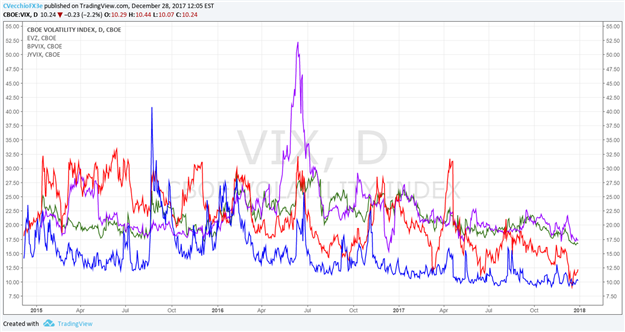Talking Points:
- Volatility measures ending 2017 near their yearly lows, and well off their highs from mid-2016.
- There were many reasons for bright spots in 2017, but significant concerns linger heading in 2018.
- Significant political risks remain ahead for both the United Kingdom and the United States.
2017 was a year defined by rising and falling tensions across the globe, leading to varying impacts on FX markets – sometimes to the extremes:
- In the United States, political partisanship reached new heights as President Donald Trump’s first term began and policy changes were overshadowed by Robert Mueller’s special probe over Russia.
- In Europe, the UK and the EU played a game of chicken over the details of Brexit, contributing to the weakest pace of wage growth in Britain in nearly 30 years.
- In the Middle East, Mohammed bin Salman, the Crown Prince of Saudi Arabia, began a corruption purge and modernization effort that will redefine his country’s role in the global economy as the transition away from fossil fuels and towards electric automobiles accelerates.
- In Asia, Kim Jung Un’s North Korea successfully tested another nuclear bomb as well as an ICBM capable of hitting any major city in the United States.
But 2017 was not all bad, and markets had good reasons to be optimistic:
- In the United States, growth began to move above +3% as stock markets hit all-time highs and the unemployment rate fell to fresh lows since the Global Financial Crisis.
- In Europe, voters pushed back against the far-right populist tide in France and Holland, with Marine Le Pen and Geerts Wilders – and their intentions to break apart the Euro – sent packing (for now; they’ll be back). The European Central Bank was able to exit part of its stimulus program as the debt crisis faded further into the background.
- In Asia and Africa, emerging market economies started to power ahead, leading the IMF to upgrade their 2017 and 2018 global growth forecasts.
Going into 2018, many of these themes – both the good and the bad – will continue to evolve and take on new forms. Even as measures of volatility end 2017 heading towards their yearly lows, history tells us that this low volatility regime won’t last forever – particularly if the forthcoming political risks evolve in the least constructive ways possible.
Chart 1: Volatility as Measured by VIX (US S&P 500), EVZ (Euro), JYVIX (Yen), and BPVIX (Sterling) (January 2016 to December 2017)

1. Will Infrastructure Provide a Lift to the Dollar or Does Trump Flounder Thanks to Mueller Probe?

If Special Investigator Robert Mueller’s Russia probe has been an albatross around US President Donald Trump’s neck, then it has also been one around the neck of the US Dollar as well. The acrimonious political climate that persists – rightly or wrongly – due to the accusations of political malfeasance during the 2016 election cycle has made bipartisan compromise on issues trumpeted by the president all but impossible – including infrastructure spending.
Now that the tax reform bill has been signed into law, markets will be quick to look for the next reason to stay optimistic – even if that means US equity markets should be well-supported through the first half of 2018. In particular, given that the economic impact of the tax bill appears to be rather limited in nature due to how the tax cuts are structured, leading only to a short-term boost to growth via deficit spending, equity markets in the United States may begin to look toppish by the second half of the year- especially if no infrastructure bill gets done.
In turn, in an environment where the tax reform bill won’t have a meaningful positive impact on the business cycle – for neither growth nor inflation expectations – it’s difficult to envision the Federal Reserve stepping up its pace of rate hikes in 2018 either.
2. Will Theresa May Keep the Brexit Negotiations on Track or Will She Lose Power?

UK Prime Minister Theresa May’s April 2017 decision to hold a snap election was widely panned and criticized once the Tories fell below the 326 seat threshold in order to have an outright majority. With now having 318 seats in parliament, the Tories’ hold on power is contingent upon the 10 seats its coalition partner, Northern Ireland’s DUP, brings with it. The deal that UK PM May made with the EU on the divorce bill, the Ireland/Northern Ireland border, and citizen’s rights has already put the relationship with the DUP to the test once. Another major disagreement could see the coalition fail, leading to another general election.
But that’s not the only route to a general election. As a result of UK PM May’s maneuvering, hard-right Brexiteers within the Tory party have started to openly rebel and question her leadership. Any sign of a so-called “hard” or “cliff-edge” Brexit, in which the UK leaves the EU without an agreement in place, would be taken badly too. Furthermore, the Brexit negotiations could become derailed as they turn to trade and related issues, and politicking becomes the norm alongside continuing arguments between May and the Tory Brexiteers.
Indeed, it’s still not impossible to imagine Theresa May being replaced as UK Prime Minister by the governing Conservative Party, a government collapse leading to the third general election in four years (which hasn’t happened since 1922-24), or further moves towards independence by the UK regions – all of which would likely hit the British Pound. The risk of a “hard” or “cliff edge” Brexit remains as a tail risk.
3. Will Populism Make a Return to Europe in 2018 via Italy?

Political risk all but disappeared in Europe in 2017 after April, when it became clear that Emmanuel Macron would become the next President of France, all but extinguishing the far-right populist surge for the rest of the year. But the conditions that led to the rise of nationalistic populism – stagnant wages, high youth unemployment, issues with immigration – remain, meaning that it remains lurking in the background as a potential threat whenever elections may arise.
For 2018, all attention in this regard turns to Italy, where as of the end of December 2017, Italian President Sergio Mattarella announced that new elections would be held by March 2018. The current Italian election law, the Italicum modified by the Italian Supreme Court in January 2017, dictates that a majority bonus (55%) in the case in which the first party (not a coalition) gets more than 40% of the vote would be awarded; if no single party reaches that threshold, the distribution of seats will follow a proportional system.
What this means is that the March 2018 elections may very well lead to a hung parliament and abrupt political stability in Italy for the rest of the year. The Five Star Movement, which currently leads in the polls but does not have more than 40% threshold of support for a majority bonus, has promised to hold a referendum to take Italy out of the European Union.
Meanwhile, former PM Matteo Renzi’s party is polling second, but would not have enough seats in a coalition with Silvio Berlusconi’s Forza Italia to form a coalition government even on the narrow grounds of keeping Italy in the EU. Italy seems destined to be a thorn in the side of the Euro for all of 2018 – particularly in the unexpected event that the Five Star Movement holds power and begins to move for an “Italeave.”
This note was originally published on December 28, 2017.
Read more: US Assets Taking Divergent Paths: Stocks Look Healthy, the Dollar Doesn’t
--- Written by Christopher Vecchio, CFA, Senior Currency Strategist
To contact Christopher, email him at cvecchio@dailyfx.com.
Follow him in the DailyFX Real Time News feed and Twitter at @CVecchioFX.
To receive this analyst’s reports, sign up for his distribution list.
Don’t trade FX but want to learn more? Read the DailyFX Trading Guides.






